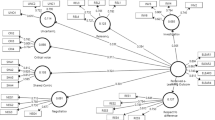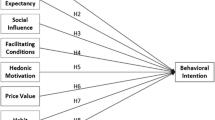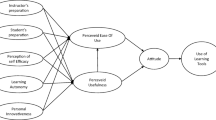Abstract
Despite the prevalence and significance of e-learning in education, there is a dearth of published instruments for educational researchers and practitioners that measure users’ acceptance of e-learning. To meet this need, Teo (2010) developed the E-learning Acceptance Measure (ElAM). The main objective of this paper is to validate the ElAM (Teo, 2010) across two cultures, one is from a European country: England, and the other from Asia: Lebanon. A total sample of 461 university students from two private universities in Lebanon (n = 209) and one university in England (n = 252) participated in this study. Using confirmatory factor analyses, our findings revealed that the original 3-factor solution for ElAM (Teo, 2010) was supported and found to be adequate for the British sample, whereas the results revealed a bad fit for the Lebanese sample. Despite the differences, the ElAM was found to possess an acceptable level of internal consistency and item reliability for the pooled sample. Theoretical and practical implications are discussed at the end of the paper.

Similar content being viewed by others
References
Abouchedid, K., & Eid, G. M. (2004). E-learning challenges in the Arab world: Revelations from a case study profile. Quality Assurance in Education, 12(1), 15–27.
Akkoyunlu, B., & Yilmaz-Soylu, M. (2008). Development of a scale on learners’ views on blended learning and its implementation process. The Internet and Higher Education, 11(1), 26–32.
Arbuckle, J. (2009). Amos 18 user’s guide. Armonk: SPSS Incorporated.
Baroud, F., & Abouchedid, K. (2010). Elearning in Lebanon: Patterns of E-learning development in Lebanon’s mosaic educational context. In U. Demiray (Ed.), E-learning practices: Cases on challenges facing e-learning and national development, institutional studies and practices (pp. 409–424). Eskisehir-Turkey: Anadolu University.
Bernard, R. M., Brauer, A., Abrami, P. C., & Surkes, M. (2004). The development of a questionnaire for predicting online learning achievement. Distance Education, 25(1), 31–47.
Blunch, N. J. (2008). Introduction to structural equation modelling using SPSS and AMOS. London: Sage.
Bollen, K. A. (1989). Structural equations with latent variables. New York: Wiley.
Byrne, B. M. (2013). Structural equation modeling with Amos: Basic concepts, applications, and programming. New York: Routledge.
Carmines, E. G., & Mciver, J. P. (1981). Analyzing models with unobserved variables: Analysis of covariance structures. In B. W. George & B. Edgar (Eds.), Social measurement: Current issues (pp. 65–115). Beverly Hills: Sage Publications, Inc.
Cavus, N. (2013). Selecting a learning management system (LMS) in developing countries: Instructors’ evaluation. Interactive Learning Environments, 21(5), 419–437.
Davis, F. D. (1989). Perceived usefulness, perceived ease of use, and user acceptance of information technology. MIS Quarterly, 13(3), 319–340.
Demiray, U. (2010). Cases on challenges facing e-learning and national development: Institutional studies and practices. Anadolu University Publications, 2(1), 63–75.
Devellis, R. F. (2011). Scale development: Theory and applications. Newbury Park: Sage.
Gefen, D., Straub, D. W., & Boudreau, M. C. (2000). Structural equation modeling and regression: Guidelines for research practice. Communications of AIS, 4(7), 1–79.
Hair, J. F. J., Black, W. C., Babin, B. J., Anderson, R. E., & Tatham, R. L. (2010). Multivariate data analysis. New Jersey: Prentice-Hall.
Harb, J., Abu Bakar, N., & Krish, P. (2014). Gender differences in attitudes towards learning oral skills using technology. Education and Information Technologies, 19(4), 805–816.
Hofstede, G., & Hofstede, J. (2005). Cultures and organizations: Software of the mind. New York: McGraw-Hill.
Hu, L., & Bentler, P. M. (1999). Cutoff criteria for fit indexes in covariance structure analysis: Conventional criteria versus new alternatives. Structural Equation Modeling: A Multidisciplinary Journal, 6, 1–55.
Janssens, W., De Pelsmacker, P., Wijnen, K., Van Kenhove, P. (2008). Marketing research with SPSS. Englewood Cliffs, NJ: Financial Times/Prentice Hall.
Kay, R. H., & Knaack, L. (2008). A multi-component model for assessing learning objects: The learning object evaluation metric (LOEM). Australasian Journal of Educational Technology, 24(5), 574–591.
Keengwe, J., & Malapile, S. (2014). Factors influencing technology planning in developing countries: A literature review. Education and Information Technologies, 19(4), 703–712.
Kline, R. B. (2010). Principles and practice of structural equation modeling (3rd ed.). New York: Guilford Press.
Kontkanen, S., Dillon, P., Valtonen, T., Renkola, S., Vesisenaho, M., & Väisänen, P. (2014). Pre-service teachers’ experiences of ICT in daily life and in educational contexts and their proto-technological pedagogical knowledge. Education and Information Technologies, 19(4), 1–25.
Lee, C.B., Teo, T., Chai, C.S., Choy, D., Tan, A., Seah, J. (2007). Closing the gap: Pre-service teachers’ perceptions of an ICT based, student centred learning curriculum. In ICT: Providing choices for learners and learning. Proceedings ascilite Singapore 2007.
Malapile, S., & Keengwe, J. (2013). Information communication technology planning in developing countries. Education and Information Technologies, 19(4), 691–701.
Mirza, A. A., & Al-Abdulkareem, M. (2011). Models of e-learning adopted in the Middle East. Applied Computing and Informatics, 9(2), 83–93.
Nunnally, J. C., & Bernstein, I. H. (1994). Psychometric theory. New York: McGraw.
Paechter, M., & Maier, B. (2010). Online or face-to-face? Students’ experiences and preferences in e-learning. The Internet and Higher Education, 13(4), 292–297.
Pallant, J. (2010). SPSS survival manual: A step by step guide to data analysis using SPSS. Buckingham: Open University Press.
Park, S. Y., Nam, M. W., & Cha, S. B. (2012). University students’ behavioral intention to use mobile learning: Evaluating the technology acceptance model. British Journal of Educational Technology, 43(4), 592–605.
Schumacker, R. E. & Lomax, R. G. (2010) A beginner's guide to structural equation modeling. New York: Routledge: Lawrence Erlbaum.
Sriram, B. (2014). Factors influencing the internet resource users satisfaction: An analytical study on omani undergraduate learners. Education and Information Technologies, 18(1), 1–17.
Stewart, I., Hong, E., & Strudler, N. (2004). Development and validation of an instrument for student evaluation of the quality of web-based instruction. American Journal of Distance Education, 18(3), 131–150.
Straub, D., Keil, M., & Brenner, W. (1997). Testing the technology acceptance model across cultures: A three country study. Information & Management, 33(1), 1–11.
Suhr, D. D. (2006). Exploratory or confirmatory factor analysis? In Statistics and data analysis (pp. 200–231). Cary: SAS Institute.
Tabachnick, B. G., & Fidell, L. S. (2007) Using multivariate statistics. Pearson Education.
Tarhini, A., Hone, K., & Liu, X. (2013a). Factors affecting students’ acceptance of E-learning environments in developing countries: A structural equation modeling approach. International Journal of Information and Education Technology, 3(1), 54–59.
Tarhini, A., Hone, K., & Liu, X. (2013b). User acceptance towards web-based learning systems: Investigating the role of social, organizational and individual factors in European higher education. Procedia Computer Science, 17, 189–197.
Tarhini, A., Hone, K., & Liu, X. (2013c). Extending the TAM model to empirically investigate the students’ behavioural intention to use e-learning in developing countries. In Science and Information Conference (SAI) (pp. 732–737), United Kingdom.
Tarhini, A., Hone, K., & Liu, X. (2014a). A cross-cultural examination of the impact of social, organisational and individual factors on educational technology acceptance between British and Lebanese university students. British Journal of Educational Technology. doi:10.1111/bjet.12169.
Tarhini, A., Hone, K., & Liu, X. (2014b). The effects of individual differences on e-learning users’ behaviour in developing countries: A structural equation model. Computers in Human Behavior, 41, 153–163.
Tarhini, A., Hone, K., & Liu, X. (2014c). Measuring the moderating effect of gender and Age on e-learning acceptance in England: A structural equation modeling approach for an extended technology acceptance model. Journal of Educational Computing Research, 51(2), 163–184
Tarhini, A., Scott, M., Sharma, K.S., & Abbasi, M.S. (2015a). Differences in Intention to Use RSS Feeds between Lebanese and British students: A Multi-Group Invariance Analysis Based on the Technology Acceptance Model. Electronic Journal of e-Learning, 13(1), 14-29.
Tarhini, A., Hassouna, M., Abbasi, M.S. & Orozco, J. (2015b). Towards the Acceptance of RSS to Support Learning: An empirical study to validate the Technology Acceptance Model in Lebanon. Electronic Journal of e-Learning, 13 (1), 30-41
Teo, T. (2009a). The impact of subjective norm and facilitating conditions on pre-service teachers’ attitude toward computer use: A structural equation modeling of an extended technology acceptance model. Journal of Educational Computing Research, 40(1), 89–109.
Teo, T. (2009b). Modelling technology acceptance in education: A study of pre-service teachers. Computers & Education, 52(2), 302–312.
Teo, T. (2010). Development and validation of the E-learning Acceptance Measure (ElAM). The Internet and Higher Education, 13(3), 148–152.
Teo, T., & Noyes, J. (2010). Exploring attitudes towards computer use among pre-service teachers from Singapore and the UK: A multi-group invariance test of the technology acceptance model (TAM). Multicultural Education & Technology Journal, 4(2), 126-135.
Teo, T. (2011). Assessing the cross-cultural validity study of the E-learning Acceptance Measure (ElAM): A structural equation modeling approach. International Journal of Educational and Psychological Assessment, 8(2), 43–53.
Teo, T., Lee, C. B., Chai, C. S., & Choy, D. (2009). Modelling pre-service teachers’ perceived usefulness of an ICT-based student-centred learning (SCL) curriculum: A Singapore study. Asia Pacific Education Review, 10(4), 535–545.
Teo, T., Wong, S. L., Thammetar, T., & Chattiwat, W. (2011). Assessing the e-learning acceptance of university students in Thailand. Australasian Journal of Educational Technology, 27(8), 1356–1368.
Thompson, B. (2004). Exploratory and confirmatory factor analysis: Understanding concepts and applications. Washington: American Psychological Association.
Venkatesh, V., & Bala, H. (2008). Technology acceptance model 3 and a aesearch agenda on interventions. Decision Sciences, 39(2), 273–315.
Venkatesh, V., Morris, M. G., Davis, G. B., & Davis, F. D. (2003). User acceptance of information technology: Toward a unified view. MIS Quarterly, 27(3), 425–478.
Zhang, Y. (2007). Development and validation of an internet use attitude scale. Computers & Education, 49(2), 243–253.
Zhang, S., Zhao, J., & Tan, W. (2008). Extending TAM for online learning systems: An intrinsic motivation perspective. Tsinghua Science and Technology, 13(2), 312–317.
Zhu, C., Valcke, M., & Schellens, T. (2009). Cultural differences in the perception of a social‐constructivist e‐learning environment. British Journal of Educational Technology, 40(1), 164–168.
Author information
Authors and Affiliations
Corresponding author
Appendix
Appendix
Rights and permissions
About this article
Cite this article
Tarhini, A., Teo, T. & Tarhini, T. A cross-cultural validity of the E-learning Acceptance Measure (ElAM) in Lebanon and England: A confirmatory factor analysis. Educ Inf Technol 21, 1269–1282 (2016). https://doi.org/10.1007/s10639-015-9381-9
Published:
Issue Date:
DOI: https://doi.org/10.1007/s10639-015-9381-9




